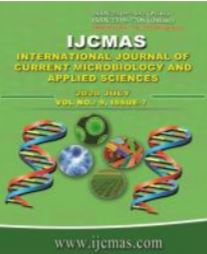


 National Academy of Agricultural Sciences (NAAS)
National Academy of Agricultural Sciences (NAAS)

|
PRINT ISSN : 2319-7692
Online ISSN : 2319-7706 Issues : 12 per year Publisher : Excellent Publishers Email : editorijcmas@gmail.com / submit@ijcmas.com Editor-in-chief: Dr.M.Prakash Index Copernicus ICV 2018: 95.39 NAAS RATING 2020: 5.38 |
The oilseed crops especially rapeseed-mustard play a pivotal role in agricultural economy of the world. In Punjab, the area under cultivation of mustard has been decreased due to Brassica crops are extremely susceptible from some major biotic and abiotic stresses. Alternaria blight caused by Alternaria brassicae is one of the most widespread and destructive fungal disease of rapeseed- mustard throughout the world. Field trials were conducted to determine the influence of two sowing dates (22nd October and 05th November) and effect of weather parameters on Alternaria blight intensity during Rabi season 2018-19. In first sowing (D1) 26.16 percent and second sowing (D2) 45.39 highest percent disease intensity (PDI) was recorded by PBR-97 and Giriraj was comparatively less disease severity in both sowing dates (D1-4.79, D2-10.65). Overall mean percent of disease severity was 17.73 and 30.35 at D1 and D2 respectively. Disease severity was increase with delay in date of sowing. Weather factors also play an important role in disease flourish. The maximum temperature (17.9-31.8°C) and minimum temperature (2.2-15.2°C) positively correlated and minimum relative humidity (30.6-63.7%), maximum relative humidity (74.1-92.6%) and rainfall had significant negative correlated with disease severity.
 |
 |
 |
 |
 |